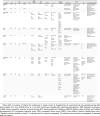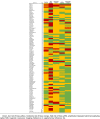Clinical Prediction Models and Predictors for Death or Adverse Neurodevelopmental Outcome in Term Newborns with Hypoxic-Ischemic Encephalopathy: A Systematic Review of the Literature
- PMID: 37536297
- PMCID: PMC10711775
- DOI: 10.1159/000530411
Clinical Prediction Models and Predictors for Death or Adverse Neurodevelopmental Outcome in Term Newborns with Hypoxic-Ischemic Encephalopathy: A Systematic Review of the Literature
Abstract
Background: Although many predictive parameters have been studied, an internationally accepted, validated predictive model to predict the clinical outcome of asphyxiated infants suffering from hypoxic-ischemic encephalopathy is currently lacking. The aim of this study was to identify, appraise and summarize available clinical prediction models, and provide an overview of all investigated predictors for the outcome death or neurodevelopmental impairment in this population.
Methods: A systematic literature search was performed in Medline and Embase. Two reviewers independently included eligible studies and extracted data. The quality was assessed using PROBAST for prediction model studies and QUIPS assessment tools for predictor studies.
Results: A total of nine prediction models were included. These models were very heterogeneous in number of predictors assessed, methods of model derivation, and primary outcomes. All studies had a high risk of bias following the PROBAST assessment and low applicability due to complex model presentation. A total of 104 predictor studies were included investigating various predictors, showing tremendous heterogeneity in investigated predictors, timing of predictors, primary outcomes, results, and methodological quality according to QUIPS. Selected high-quality studies with accurate discriminating performance provide clinicians and researchers an evidence map of predictors for prognostication after HIE in newborns.
Conclusion: Given the low methodological quality of the currently published clinical prediction models, implementation into clinical practice is not yet possible. Therefore, there is an urgent need to develop a prediction model which complies with the PROBAST guideline. An overview of potential predictors to include in a prediction model is presented.
Keywords: Asphyxia; Neonatal; Outcome; Prediction; Systematic review.
© 2023 The Author(s). Published by S. Karger AG, Basel.
Conflict of interest statement
The authors have no conflicts of interest to declare.
Figures




Comment in
-
Prognosticating the Outcomes of HIE with Certainty: Mission Impossible? - Commentary on "Clinical Prediction Models and Predictors for Death or Adverse Neurodevelopmental Outcome in Term Newborns with Hypoxic Ischemic Encephalopathy: A Systematic Review of the Literature".Neonatology. 2023;120(5):670-672. doi: 10.1159/000531189. Epub 2023 Jun 28. Neonatology. 2023. PMID: 37379813 No abstract available.
References
Publication types
MeSH terms
LinkOut - more resources
Full Text Sources

